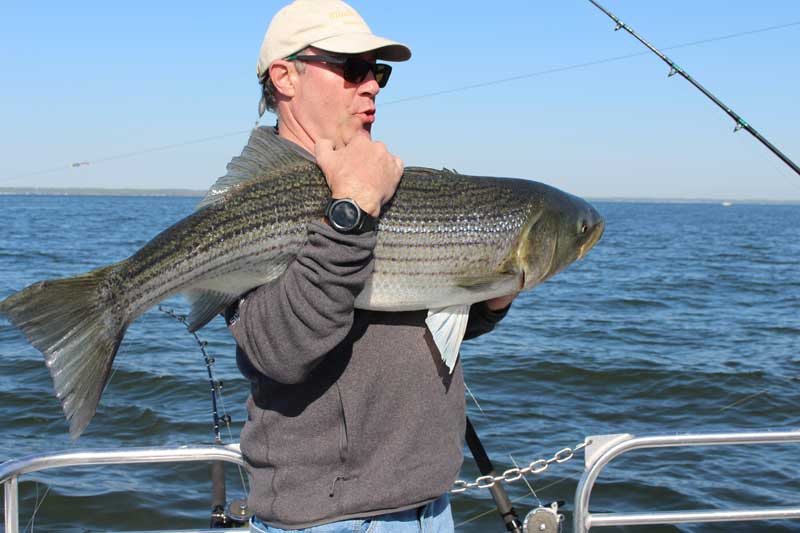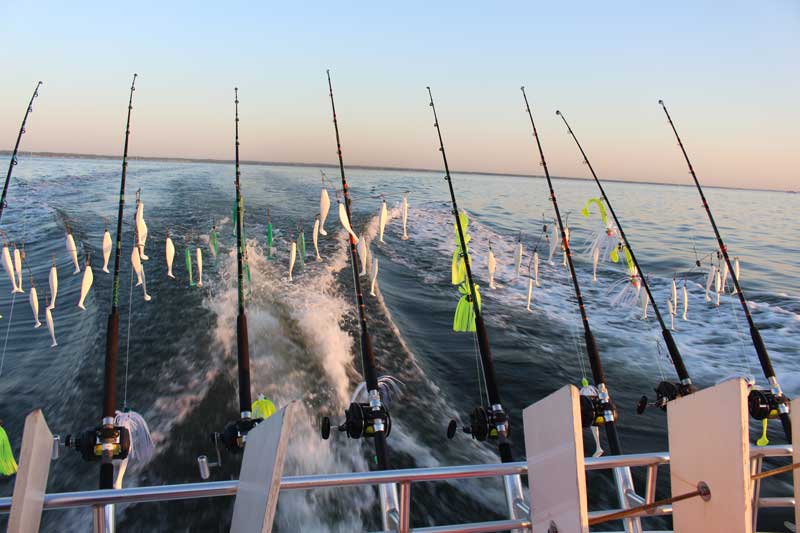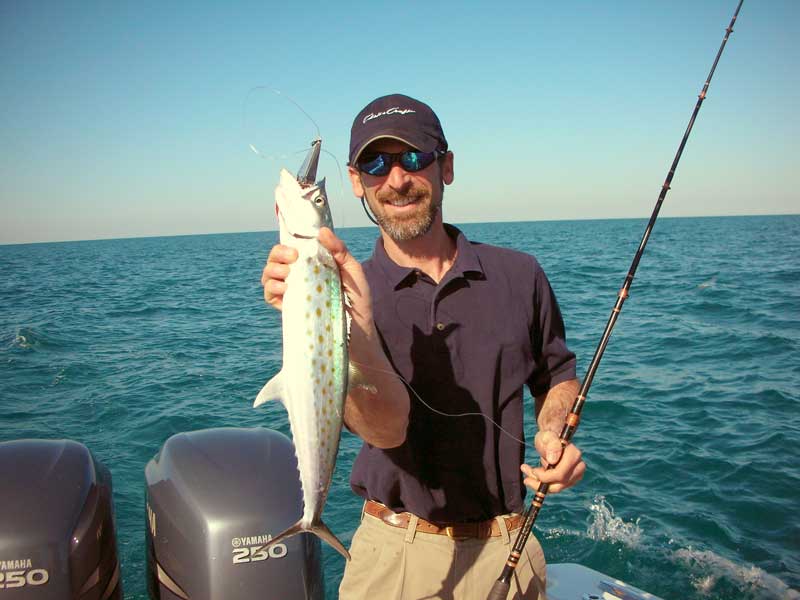Last month in Gearing Up Part I: Choosing the Ideal Ultralight we looked at one end of the spectrum and this month, we're heading to the opposite end as we consider the best trolling gear. Using the improper gear for trolling Bay waters is a sure-fire recipe for disaster, or at least a recipe for catching less fish. Wait a sec – that is a disaster! Don’t let a lack of tackle get in your way of catching more, bigger fish. And when you head to the tackle shop to get your new outfits, remember:

Trolling Rods
These need to be beefy enough to handle some serious weight. Overload a rod with weight so it’s constantly bent over like a noodle, and when a fish strikes there’s no give left to absorb the blow. Net result? A break-off or pulled hook. Of course, just how much weight you’ll be towing does depend to a large degree on the fishery. Spring trophy striper trolling rods need to be quite hefty to support the drag of umbrellas and heavy tandems; as a result, most anglers opt for gear in the 40-pound class or heavier.
Summer trolling with six-inch baits and small spoons or hoses can be accomplished with 20- or 30-pound gear, and lightening things up a bit makes for a much better fight when schoolie stripers or taylor bluefish are what’s hitting. Yet if you pull planers for Spanish mackerel or need to add lots of lead to get down deep, those heavier rigs come back into play. The bottom line? To really do things right and be a Chesapeake trolling high-liner, you really should have at least two sets of rods – one in the 20- to 30-pound class, and one that’s 40-plus.
So far as length goes, there’s no need to get carried away. Bay rods don’t need to be super-long, and longer rods create a longer fulcrum – which means you work harder when there’s a fish on the line. Five-foot, six-inch rods are plenty long, six-foot, six-inch rods are okay too, and pumping a seven-footer will feel like doing push-ups.
What about rod guides? There was a time when serious trollers believed roller guides were a must. That time is long gone. Today’s ceramic inserts are every bit as gentle on your line, and they don’t require the regular maintenance those old-school rollers.

Finally, consider grips and butts type. Most modern rods have neoprene foam grips, and neoprene or stainless-steel butts. Which you choose is really a matter of personal preference more than anything else. The butt cap is a much more important part to consider. Some are gimbaled, some are round, and some are gimbaled but come with a removable butt cap. Those caps seem like a great idea, until one comes off and gets stuck in your rodholder. Trust us, it will happen. Instead of choosing these a much better move is to opt for gimbaled and buy appropriate rod-belts, or get rods with round butt caps and recognize that you’ll be sticking the butt in your gut.
Trolling Reels
Reels one piece of gear where quite honestly, you get a break. A price break, that is, because the fancy (expensive) lever-drags and beautiful (expensive) anodized aluminum body plates seen on offshore trolling reels aren’t really a necessity. Standard-issue star-drag models with enough line capacity to hold 400-plus yards of 40-pound braid are the norm, and if a reel can put out 15 pounds of drag, it has more than enough beef to tackle anything you’ll encounter while trolling the Bay.
One thing you do want to look for is a level-wind model. True, these can’t handle drag-screaming runs from the likes of tuna or wahoo. But they don’t need to. (Not unless this global warming thing takes a really radical twist, and marlin start migrating up to Matapeake… hey a guy can dream, can’t he?) And even if you know how to level wind with your thumb, that doesn’t mean cousin Bubba won’t make a mess out of things on your next trip. In the long run, the way level-winders evenly spread the line along your spool will prevent countless tangles.
Fishing Line used by anglers trolling in the Bay has mostly evolved to become braid, at this point. Monofilament has way more stretch and water-resistance, and those of us who still have reels spooled with monel or stainless-steel have hair just as silver as those lines. Most agree that 40-pound test is minimal, and many favor 50- or even 60-pound test.
Other Trolling Gear
Some additional gear you’ll need for trolling on the Bay is to some degree a matter of personal preference, but there are a few must-haves we’d be negligent to not mention. First off, lead – you’ll need lots and lots of lead in the form of torpedo sinkers, ranging from and ounce or two to 18 or 20 ounces. If you plan on bottom-bouncing, you need eight to 20-ounce dipsy sinkers as well. Swivels, leader, and rigging gear all need to be aboard, too. Warning: if you troll spoons or hoses, don’t cheap out when you buy those swivels. It takes a real ball-bearing swivel to prevent line twist while trolling with these lures, and buying those inexpensive snap swivels will lead to uncontrollable twists and kinks in your line.
Another item that’s important to consider is your landing net. A long-handled net is advantageous when trolling, since it lets you reach far aft while the boat’s moving forward. Buy one with the largest hoop possible, unless you think it’s fun to lose the biggest fish of your life because you wanted to save 10 bucks. And any angler who gives a dang will specifically choose a new with rubberized mesh, not knotted nylon, because it’s much better for any fish you may end up releasing – that knotted mesh rubs away their slime, which can lead to infection.

Finally, don’t forget to grab in-line planers if you want to target Spanish mackerel; planer boards, clips, and the associated gear if you intend to troll for spring trophies; wire leader for when bluefish are around; clippers; snippers; rubber bands; rulers… And of course, a wide selection of lures.
Also See: